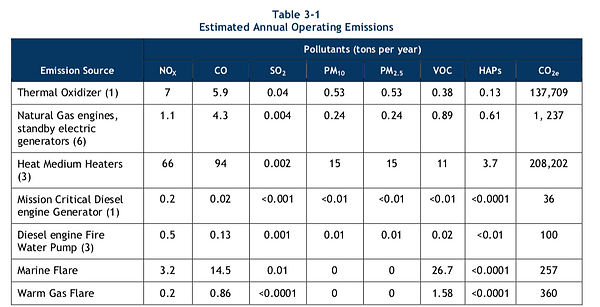
Purifying and liquefying natural gas is a major source of pollution!
The LNG facilities would be the biggest polluters in the Rio Grande Valley. The industry is known to say "clean burning natural gas" to insinuate that natural gas is a clean source of energy. This is very misleading because "burning" is the end of the value chain. Natural gas is produced and the steps of exploration, fracking, extraction, processing, pipeline transport, liquefaction, shipment, re-gassification, and delivery to the consumer is very polluting.
The pollutants LNG companies will be emitting can have serious health effects and will have significant impact on our environment and contribute to climate change. Click on the following links to jump down the page for the corresponding information.
The Pollutants

Graphic created by Rain Forest Action Network
Nitrogen Oxides

Nitrogen oxides are poisonous gases that form smog, worsen asthma symptoms, and damage lungs. They make up the 'brown' in the brown cloud and could produce visible pollution in the area of the LNG plants.
Carbon Monoxide

Carbon Monoxide is a poison produced when fossil fuels do not burn completely. It is particularly harmful to pregnant women, fetuses, and babies.
Volatile Organic Compounds (VOCs)

Volatile organic compounds (VOCs) are chemicals that contribute to smog, pollute water, and some, like benzene and toluene, are carcinogens and neurotoxins. There is no safe level of these highly toxic chemicals, so any amount is a problem.
Particulates
Particulate matter is a mixture of extremely small particles and liquid droplets that are small enough to be inhaled and cause respiratory damage. Children and the elderly are especially vulnerable to particulate matter.
Green House Gases
Green House Gases trap heat in the atmosphere and contribute to climate change. The two largest green house gas emitters in Cameron County, the Silas Ray power plant and the Brownsville municipal landfill, together produce only 130,815 tons each year.
Sulfur Dioxide
Sulfur dioxide forms acids that harm marine life and kill plants. These pollutants would be emitted right next door to crucial wetlands and other habitat.
Annova LNG Air Emissions


Annova LNG Resource Report 9
Rio Grande LNG Air Emissions
Data from Rio Grande LNG Resource Report 9
Detailed listing of sources of pollutants from terminal and compressor station 3
Texas LNG Air Emissions







